Ditapis dengan
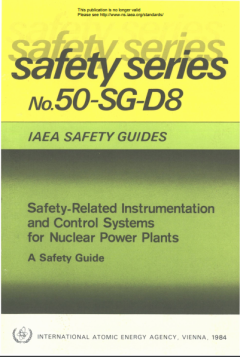
Safety-Related Instrumentation and Control System For Nuclear Power Plants
The systems which perform the vitai functions of monitoring and controlling systems and parameters at nuclear power plants are known as instrumentation and control (I&C) systems*. They are divided into two types: information systems and control systems. Both types operate by providing signals from measuring equipment. Information systems monitor plant parameters and systems; they display and…
- Edisi
- -
- ISBN/ISSN
- -
- Deskripsi Fisik
- -
- Judul Seri
- Safety Series No. 50-SG-D8
- No. Panggil
- 621.48 IAE s
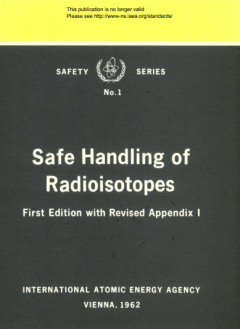
Safe Handling Of Radioisotopes, First Editions With Revised Appendix 1
Under its Statute the International Atomic Energy Agency is empowered to provide for the application of standards of safety for protection against radiation to its own operations and to operations making use of assistance provided by it or with which it is otherwise directly associated. To this end authorities receiving such assistance are required to observe relevant health and safety measures…
- Edisi
- -
- ISBN/ISSN
- -
- Deskripsi Fisik
- -
- Judul Seri
- Safety Series No.1
- No. Panggil
- -
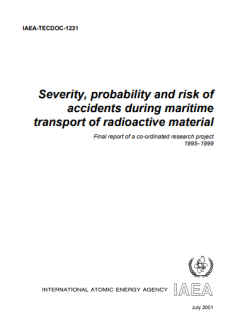
Severity, Probability and Risk of Accident During Maritime Transport of Radio…
The primary purpose of this CRP was to provide a co-ordinated international effort to assemble and evaluate relevant data using sound technical judgement concerning the effects that fires, explosions or breaches of hulls of ships might have on the integrity of radioactive material packages. The probability and expected consequences of such events could thereby be assessed. If it were shown that…
- Edisi
- -
- ISBN/ISSN
- -
- Deskripsi Fisik
- -
- Judul Seri
- IAEA-TECDOC-1231
- No. Panggil
- 363.1799 IAE s
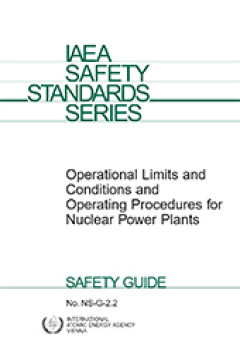
Operating Limits and Conditions and Operational Limits Procedures for Nuclear…
This Safety Guide provides guidance on the development, content and use of operational limits and conditions (limits on plant operating parameters) and operating procedures that affect them. It recommends how to meet the requirements established in Safety Standards Series No. NS-R-2, Safety of Nuclear Power Plants: Operation, setting out the responsibilities of the operating organization in set…
- Edisi
- -
- ISBN/ISSN
- -
- Deskripsi Fisik
- 52 p. : Illus. ; 24 cm
- Judul Seri
- Safety Standards Series No. NS-G-2.2
- No. Panggil
- 621.48 IAE d
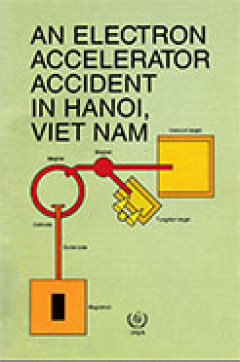
An Electron Accelerator Accident in Hanoi, Viet Nam
n 17 November 1992 a radiological accident occurred at an electron accelerator facility in Hanoi, Viet Nam. An individual entered the irradiation room without the operators' knowledge and unwittingly exposed his hands to the X ray beam. His hands were seriously injured and one hand had to be amputated. The report details the circumstances of the accident, its medical consequences and the govern…
- Edisi
- -
- ISBN/ISSN
- 9201004966
- Deskripsi Fisik
- 36 p. : Illus. ; 24 cm
- Judul Seri
- -
- No. Panggil
- 537.5 IAE a
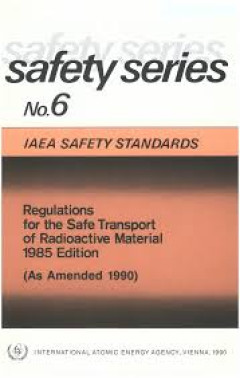
Regulations for the Safe Transport of Radioactive Material, 1985 Edition (As …
This book contain of seven section: Section I. Introduction; Section II. General provisions; Section III. Activity and fissile material limits; Section IV. Preparation, requirements and controls for shipment and for storage in transit; Section V. Requirements for radioactive materials and for packagings and packages; Section VI. Test procedures; and Section VII. Approval and administrative requ…
- Edisi
- -
- ISBN/ISSN
- 9201238908 / 00741892
- Deskripsi Fisik
- 112 p. : Illus. ; 24 cm
- Judul Seri
- Safety Series No. 6
- No. Panggil
- 539.7 IAE r
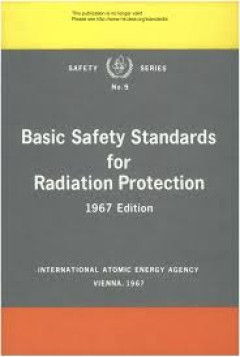
The Use of Film Badges for Personnel Monitoring
This book consist of chapter I. Introduction; 2. The Photographic Process, a review of terms and concepts; 3. Application of the photocraphic technique to personnel monitoring; 4. Requirements for setting up a photographic personnel monitoring service; and 5. Examples of photographic personnel monitoring procedure. (Jml)
- Edisi
- -
- ISBN/ISSN
- -
- Deskripsi Fisik
- 87 p. : Illus. ; 21 cm
- Judul Seri
- Safety Series No. 8
- No. Panggil
- -

Basic Safety Standards for Radiation Protection, 1967 Edition
This first revision of the Basic Safety Standards was approved by the IAEA board of Governors in September 1965. It was prepared with the assistance of a panel of experts chaired by Prof. L. Bugnard, Director of the French Institut National d'Hygiene, and attended by representatives of several international organizations. (Jml)
- Edisi
- -
- ISBN/ISSN
- -
- Deskripsi Fisik
- 79 p. : Illus. ; 21 cm
- Judul Seri
- Safety Series No. 9
- No. Panggil
- -
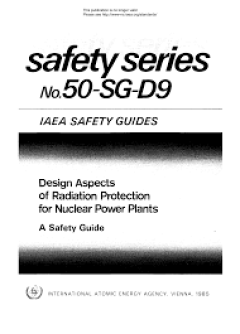
Design Aspects of Radiation Protections for Nuclear Power Plants, Safety Guides
This Safety Guide provides principles and practical details on the provisions to be made in the design of nuclear power plants to protect site personnel and the general public from ionizing radiation during operational states and accident conditions. The dose limitation systems, including the ALARA principle, are described as the basis for appropriately addressing the radiation protection featu…
- Edisi
- -
- ISBN/ISSN
- 9206231847
- Deskripsi Fisik
- 48 p. : Illus. ; 24 cm
- Judul Seri
- Safety Series No. 50-SG-D9
- No. Panggil
- 621.48 IAE s

Nuclear Power Reactors in the World
This is the 32nd edition of Reference Data Series No. 2, which presents the most recent reactor data available to the IAEA. It contains summarized information as of the end of 2011 on power reactors that are in operation, under construction and shut down, and performance data on reactors operating in IAEA Member States, as reported to the IAEA. The information is collected through designated na…
- Edisi
- 2012
- ISBN/ISSN
- 9789201323101
- Deskripsi Fisik
- -
- Judul Seri
- -
- No. Panggil
- 539 IAE n
 Karya Umum
Karya Umum  Filsafat
Filsafat  Agama
Agama  Ilmu-ilmu Sosial
Ilmu-ilmu Sosial  Bahasa
Bahasa  Ilmu-ilmu Murni
Ilmu-ilmu Murni  Ilmu-ilmu Terapan
Ilmu-ilmu Terapan  Kesenian, Hiburan, dan Olahraga
Kesenian, Hiburan, dan Olahraga  Kesusastraan
Kesusastraan  Geografi dan Sejarah
Geografi dan Sejarah